Due Thurs. 1/25: Read Sects. 1.4 and 1.6.
Due Fri. 1/26: Do Ch. 11, ## 5, 8, 10
HOMEWORK II
Due Mon. 1/29: Read Sect. 11.2.
Due Wed. 1/31:
Due Fri. 2/2:
Due Mon. 2/5: Read Sect. 11.3.
HOMEWORK III
Due Wed. 2/7:
Due Thurs. 2/8:
Due Mon. 2/12: Read Sect. 11.4.
Problem Set A
A1. In each graph, find a Hamilton cycle or prove there is none.
HOMEWORK IV
Due Wed. 2/14:
Due Thurs. 2/15:
Hand in Mon. 2/19:
Due Mon. 2/19:
Problem Set B
B1. In each graph, find a Hamilton cycle or prove there is none.
B2. In each graph, find a Hamilton chain or prove there is none.
B3. Are the graphs Y and Z isomorphic?
B4. Find a shortest postman tour in graph X.
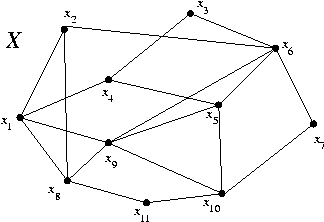
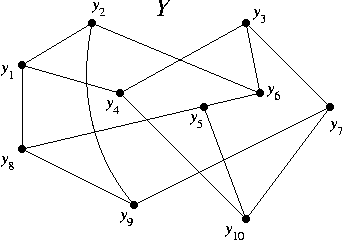
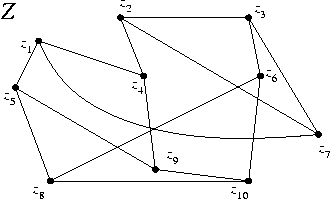

HOMEWORK V
Due Mon. 2/26:
Due Wed. 2/28:
Due Thurs. 3/1:
Hand in Mon. 3/4:
HOMEWORK VI
Due Mon. 3/5:
Due Wed. 3/7:
Due Thurs. 3/8:
Due Fri. 3/9:
Hand in Mon. 3/19:
Problem Set C
C1. For each number sequence, is it the degree sequence of a tree? If it is, produce a tree whose degree sequence is the given number sequence. You may use Exercise 11.57 as necessary.
C2. In the following diagrams, you need to follow a path from region to region (NOT from vertex to vertex), that starts in any region, goes from one region to another by crossing an edge, crosses every edge exactly once, and doesn't go through any vertex. Can you do it? If not, what is the largest number of edges it is possible to cross?
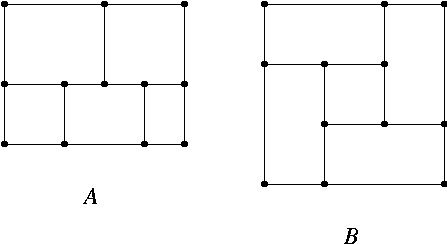
C3. Use Dijkstra's algorithm to find a distance tree in Figure 11.43 with root x, where x is the middle vertex at the bottom. How does it compare with the distance tree rooted at u?
HOMEWORK VII
Due Mon. 3/19:
Due Wed. 3/21:
Due Thurs. 3/22:
Due Fri. 3/23:
Hand in Mon. 3/26:
Problem Set D
D1. Find a minimum-weight spanning tree in Figure 11.38 by Prim's algorithm, starting with vertex d. How does your tree compare with the one found in the book starting from a?
D2. Find a distance tree by Dijkstra's algorithm in Figure 11.38:
D3. In Figure 11.38, change all weights 1 to 6. Now:
D4. Based on your answers to Problems 80-85(b), what do you expect the answers to be to 80-85(c)? How about the same questions for general Kn? You should try to solve this without actually doing any algorithms. If you come up with answers, can you prove any of them?
HOMEWORK VIII
Due Mon. 4/2:
Due Wed. 4/4:
Due Thurs. 4/5:
Hand in Fri. 4/6:
Problem Set E
E1. Prove that a tournament is transitive if and only if it has no directed cycles.
HOMEWORK IX (with SUPPLEMENT}
Due Wed. 4/11:
Due Thurs. 4/12:
Hand in Wed. 4/18:
Problem Set F
F1. Find chi(W_k), alpha(W_k), and omega(W_k) (see Announcements for definitions) for
F2. Find chi(G), alpha(G), and omega(G) for the Grötzsch graph shown here:
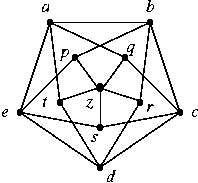
HOMEWORK X
Due Wed. 4/18: Read all of Sect. 13.1.
Due Thurs. 4/19:
Due Fri. 4/20:
Hand in Mon. 4/23:
Problem Set G
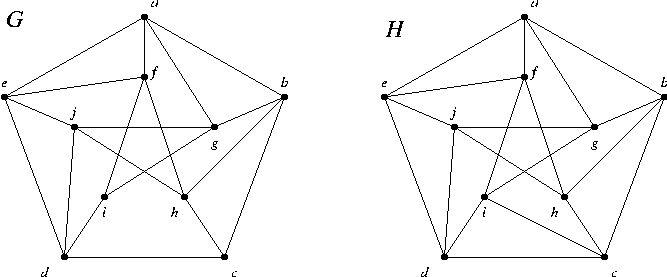
HOMEWORK XI
Due Mon. 4/23:
Due Thurs. 4/26:
Due Fri. 4/27:
Hand in Mon. 4/30:
Problem Set H
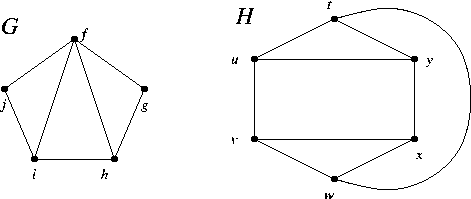
Go to announcements | course information.